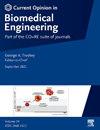Recent advances in facilitating the translation of bioelectronic medicine therapies
IF 4.2
3区 工程技术
Q2 ENGINEERING, BIOMEDICAL
引用次数: 0
Abstract
Bioelectronic medicine is a growing field which involves directly interfacing with the vagus, sacral, enteric, and other autonomic nerves to treat conditions. Therapies based on bioelectronic medicine could address previously intractable diseases and provide an alternative to pharmaceuticals. However, translating a bioelectronic medicine therapy to the clinic requires overcoming several challenges, including titrating stimulation parameters to an individual's physiology, selectively stimulating target nerves without inducing off-target activation or block, and improving accessibility to clinically approved devices. This review describes recent progress towards solving these problems, including advances in mapping and characterizing the human autonomic nervous system, new sensor technology and signal processing techniques to enable closed-loop therapies, new methods for selectively stimulating autonomic nerves without inducing off-target effects, and efforts to develop open-source implantable devices. Recent commercial successes in bringing bioelectronic medicine therapies to the clinic are highlighted showing how addressing these challenges can lead to novel therapies.
促进生物电子医学疗法翻译的最新进展。
生物电子医学是一个正在发展的领域,它涉及直接与迷走神经、骶神经、肠神经和其他自主神经相结合来治疗疾病。基于生物电子医学的治疗方法可以解决以前难以治愈的疾病,并提供药物的替代方案。然而,将生物电子医学疗法转化为临床需要克服几个挑战,包括根据个体生理学滴定刺激参数,有选择地刺激目标神经而不引起脱靶激活或阻滞,以及提高临床批准设备的可及性。本文介绍了解决这些问题的最新进展,包括绘制和表征人类自主神经系统的进展,实现闭环治疗的新传感器技术和信号处理技术,选择性刺激自主神经而不引起脱靶效应的新方法,以及开发开源植入式设备的努力。最近在将生物电子医学疗法引入临床方面的商业成功突出显示了如何解决这些挑战可以导致新的疗法。
本文章由计算机程序翻译,如有差异,请以英文原文为准。
求助全文
约1分钟内获得全文
求助全文
来源期刊

Current Opinion in Biomedical Engineering
Medicine-Medicine (miscellaneous)
CiteScore
8.60
自引率
2.60%
发文量
59
 求助内容:
求助内容: 应助结果提醒方式:
应助结果提醒方式:


